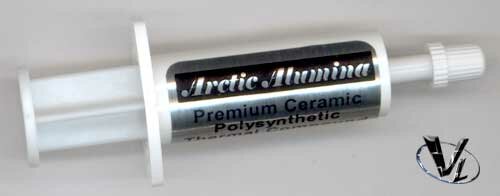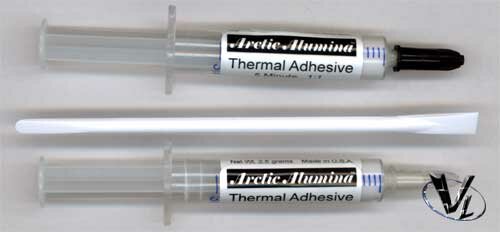|
Arctic Alumina

Arctic Silver shouldn't need any introduction for most of you. Well known for the original Arctic Silver, followed by Arctic Silver 2, they are often imitated, but rarely matched. The quality of their products is excellent, but one knock against them is the price. They hope to change that with the Arctic Alumina, which sells for about half of what Arctic Silver 2 sells for, and performs closely.
Unlike most generic compounds, Arctic Silver doesn't just shove white grease into a syringe. Alumina is composed of a layered composite of aluminum oxide and boron nitride. I'm no chemist, but according to them, this process produces performance near Arctic Silver 2 levels. If it isn't obvious by now, Arctic Alumina is not a silver compound like Arctic Silver 1 or 2 was. Here are the specifications from their site:
Arctic Alumina Compound uses a layered composite of aluminum oxide and boron nitride to provide near Arctic Silver II level performance.
Arctic Alumina Compound is a pure electrical insulator, neither electrically conductive nor capacitive.
Arctic Alumina Compound does not contain any silicone. The suspension fluid is a proprietary combination of advanced polysynthetic oils.
Arctic Alumina is sold in 1.75 gram tubes. This is enough compound to cover at least 25 to 35 small CPU cores, or 9 to 15 large CPU cores, or 4 to 8 heat plates.
At a layer 0.003" thick, it will cover approximately 24 square inches.
Although lighter per tube than Arctic Silver II due to its use of ceramics rather than silver, each tube of Arctic Alumina actually contains slightly more compound by volume than a tube of Arctic Silver II and will cover MORE area.
Arctic Alumina is engineered for controlled triple phase viscosity.
The complex polysynthetic oils work together to provide three distinctive functional phases. As it comes from the tube, Arctic Alumina's consistency is optimized for easy application in a thin, even layer. During the CPU's initial use, the Arctic Alumina compound thins out to enhance the filling of the microscopic valleys and insure the best physical contact between the heatsink and CPU core. Then the compound thickens slightly over the next 20 to 100 hours of use to its final consistency designed for long-term stability.
Note the last paragraph. Much like what was said by Nanotherm, there is a break-in period for Alumina. It's worded a little differently of course, but the idea is that it takes a few hours until the performance will level off.
I didn't mention it earlier, but one other knock I had on Arctic Silver was that it's extremely hard to clean. It isn't hard to get off the CPU die, but if you rub any on the rest of the CPU (Athlon XP owners will know exactly what I'm talking about), it can be really tough to get off. I didn't have any problems with the Alumina though. A bit of rubbing alcohol and a lint free cloth, and off it came.
Let's take a look at their new flagship compound...
Arctic Silver 3

I've been using Arctic Silver 2 for quite a while now, and pretty much stick to it as my primary compound. I like it because it's really easy to spot visually how much you've put on it, and it performs consistently. Nevin @ Arctic Silver dropped me a line not too long ago that the successor of AS2 is out, and it outperforms it.
Arctic Silver 3's claim to fame is that it's the first silver based, polysynthetic based compound on the market. Unlike their previous version, AS3 has no silicone. Although it's still silver, it has a goldish tint to it if looked at side-by-side with AS2. Here are the specifications directly from their site...
The first silver-based, polysynthetic thermal compound for use between modern high-power CPUs and high performance heatsinks or water-cooling solutions.
Arctic Silver 3 features:
Made with 99.9% pure micronized silver.
Arctic Silver 3 uses three unique shapes and sizes pure silver particles to maximize particle-to-particle contact area and thermal transfer. This exclusive combination gives the compound a distinctive silver-green color as each type of particle reflects light differently.
Over 70% silver content by weight.
Arctic Silver 3 also contains a small percentage of specially engineered micronized boron nitride. The thermally-enhanced boron nitride ceramic particles improve the compound's flow characteristics and long-term stability.
Extended temperature limits: 40°C to >160°C
Arctic Silver 3 will not run or separate.
Controlled triple phase viscosity.
Arctic Silver 3 does not contain any silicone. The suspension fluid is a proprietary mixture of advanced polysynthetic oils that work together to provide three distinctive functional phases. As it comes from the tube, Arctic Silver 3's consistency is engineered for easy application in a thin even layer. During the CPU's initial use, the compound thins out to enhance the filling of the microscopic valleys and insure the best physical contact between the heatsink and the CPU core. Then the compound thickens slightly over the next 50 to 200 hours of use to its final consistency designed for long-term stability.
Thermal conductivity: >9.0 W/m°K (Hot Wire Method Per MIL-C-47113)
Thermal Resistance: <0.0024°C-in²/Watt (0.001 inch layer)
4 to 15 degrees centigrade lower CPU core temperatures than standard thermal compounds or thermal pads.
Negligible electrical conductivity.
Arctic Silver 3 was formulated to conduct heat, not electricity. It is only electrically conductive in a thin layer under extreme compression.
(While much safer than electrically conductive silver and copper greases, Arctic Silver 3 should be kept away from electrical traces, pins, and leads. The compound is slightly capacitive and could potentially cause problems if it bridged two close-proximity electrical paths.)
Arctic Silver 3 is sold in 3 gram and 6 gram tubes. The 3 gram tube contains enough compound to cover at least 20 to 30 small CPU cores, or 7 to 12 large CPU cores, or 3 to 6 heat plates. At a layer 0.003" thick, the 3 gram tube will cover approximately 18 square inches.
Again, like everyone else, there is a break-in period. Application was a snap, but cleaning it was still tough to do.
That's it for the compounds, so before the tests begin, we'll look at the thermal adhesives we also aquired...
Nanotherm Thermal Epoxy

Scott @ ESG Associates sent over a sample of their prototype thermal adhesive. There isn't much documentation about it on their web site, but if you're familiar with epoxy application, this is applied in similar situations.
Arctic Alumina Adhesive

Nevin @ AS also sent us some adhesive as well. It should be noted that it is very clear on Arctic Silver's site that this product shouldn't be used on CPUs.
The epoxy comes in two syringes for both manufacturers, and must be applied in a 1:1 ratio. Having worked with epoxy a few times, my advice is to apply it quickly after mixing, as it gets harder to spread after. I used it on my video card heatsink, and the pressure from the HSF clips was enough to keep a firm grip. It takes about 5 minutes to set.
I probably should have mentioned this earlier, but both epoxy solutions are permanent. Because I needed to test both of them, and only have a couple of video cards to test with, I needed to dilute both mixtures. I'm still going to provide numbers for both of them, but because I'm changing the properties somewhat, my results may not reflect what you might see elsewhere.
To dilute them, I applied the 1:1 ratio for each. I then added an equal part of either Nanotherm Ice or Arctic Alumina (depending on which epoxy I was using) to the mix. It's still tough to separate after, but not as tough as it would be had I not diluted the mixture.
Ok, enough talk, let's get to the benchmarks...
Previous Page - Nanotherm Products
Next Page - Testing and Final Words
|
